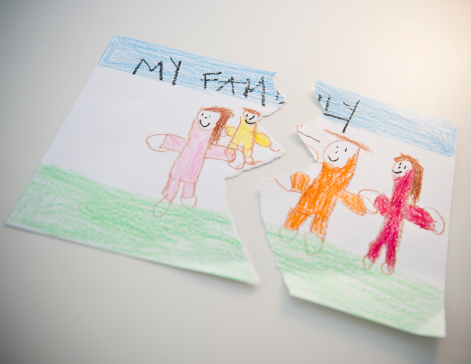 In”The Importance of Attachment: Part I“, I outlined the key developmental value of a secure attachment relationship between a child and a parent. Secure attachment is the foundation of resilience. Adverse life events, like a divorce, can be mastered by resilient children, especially if their secure attachments are not threatened by the divorce. As a Neutral Child Specialist, my goal is to make sure that the crisis of a divorce does not become a trauma for a child.
I recently attended a workshop on the Adult Attachment Interview (AAI), a series of questions that allows researchers to understand how well an adult has integrated his or her own life experiences, both positive and adverse. Adults who have managed to integrate their experiences into a coherent narrative are considered securely attached. Unfortunately, according to a number of research studies, only about half of all adults have secure attachments as measured by the AAI. The remainder have not been able to integrate adverse experiences, and remain either highly anxious or disconnected from them. Some insecurely attached adults who were traumatized as children live in constant emotional chaos. Researchers speculate that the quality of adult attachment is related to how capable a person is to form an emotionally safe, committed and loving relationship with another adult.
Numerous longitudinal research studies have discovered another impact of adult attachment. There is a very high level of correlation between how an adult responds on the AAI and the subsequent quality of attachment that adult is able to create with his or her own child. Compellingly, the life story a person tells on the AAI is a stronger predictor of quality of attachment with his or her child than actual observed parental behavior. In other words, the impact of emotional distress and trauma in childhood will reverberate across generations unless a parent gets the necessary support and healing to integrate his or her life into a coherent narrative. It is possible for adults to shift from insecurely attached to securely attached, but it requires the healing that comes from therapeutic relationships.
Obviously the best way to ensure secure attachments for generations of children is to prevent trauma in their lives. Of all the reasons to select a divorce process that supports respectful and healthy resolutions and builds the foundation for effective co-parenting, it is the legacy of secure attachment that will be left for your children and future generations. Collaborative Practice is one such process.
In”The Importance of Attachment: Part I“, I outlined the key developmental value of a secure attachment relationship between a child and a parent. Secure attachment is the foundation of resilience. Adverse life events, like a divorce, can be mastered by resilient children, especially if their secure attachments are not threatened by the divorce. As a Neutral Child Specialist, my goal is to make sure that the crisis of a divorce does not become a trauma for a child.
I recently attended a workshop on the Adult Attachment Interview (AAI), a series of questions that allows researchers to understand how well an adult has integrated his or her own life experiences, both positive and adverse. Adults who have managed to integrate their experiences into a coherent narrative are considered securely attached. Unfortunately, according to a number of research studies, only about half of all adults have secure attachments as measured by the AAI. The remainder have not been able to integrate adverse experiences, and remain either highly anxious or disconnected from them. Some insecurely attached adults who were traumatized as children live in constant emotional chaos. Researchers speculate that the quality of adult attachment is related to how capable a person is to form an emotionally safe, committed and loving relationship with another adult.
Numerous longitudinal research studies have discovered another impact of adult attachment. There is a very high level of correlation between how an adult responds on the AAI and the subsequent quality of attachment that adult is able to create with his or her own child. Compellingly, the life story a person tells on the AAI is a stronger predictor of quality of attachment with his or her child than actual observed parental behavior. In other words, the impact of emotional distress and trauma in childhood will reverberate across generations unless a parent gets the necessary support and healing to integrate his or her life into a coherent narrative. It is possible for adults to shift from insecurely attached to securely attached, but it requires the healing that comes from therapeutic relationships.
Obviously the best way to ensure secure attachments for generations of children is to prevent trauma in their lives. Of all the reasons to select a divorce process that supports respectful and healthy resolutions and builds the foundation for effective co-parenting, it is the legacy of secure attachment that will be left for your children and future generations. Collaborative Practice is one such process.
 In”The Importance of Attachment: Part I“, I outlined the key developmental value of a secure attachment relationship between a child and a parent. Secure attachment is the foundation of resilience. Adverse life events, like a divorce, can be mastered by resilient children, especially if their secure attachments are not threatened by the divorce. As a Neutral Child Specialist, my goal is to make sure that the crisis of a divorce does not become a trauma for a child.
I recently attended a workshop on the Adult Attachment Interview (AAI), a series of questions that allows researchers to understand how well an adult has integrated his or her own life experiences, both positive and adverse. Adults who have managed to integrate their experiences into a coherent narrative are considered securely attached. Unfortunately, according to a number of research studies, only about half of all adults have secure attachments as measured by the AAI. The remainder have not been able to integrate adverse experiences, and remain either highly anxious or disconnected from them. Some insecurely attached adults who were traumatized as children live in constant emotional chaos. Researchers speculate that the quality of adult attachment is related to how capable a person is to form an emotionally safe, committed and loving relationship with another adult.
Numerous longitudinal research studies have discovered another impact of adult attachment. There is a very high level of correlation between how an adult responds on the AAI and the subsequent quality of attachment that adult is able to create with his or her own child. Compellingly, the life story a person tells on the AAI is a stronger predictor of quality of attachment with his or her child than actual observed parental behavior. In other words, the impact of emotional distress and trauma in childhood will reverberate across generations unless a parent gets the necessary support and healing to integrate his or her life into a coherent narrative. It is possible for adults to shift from insecurely attached to securely attached, but it requires the healing that comes from therapeutic relationships.
Obviously the best way to ensure secure attachments for generations of children is to prevent trauma in their lives. Of all the reasons to select a divorce process that supports respectful and healthy resolutions and builds the foundation for effective co-parenting, it is the legacy of secure attachment that will be left for your children and future generations. Collaborative Practice is one such process.
In”The Importance of Attachment: Part I“, I outlined the key developmental value of a secure attachment relationship between a child and a parent. Secure attachment is the foundation of resilience. Adverse life events, like a divorce, can be mastered by resilient children, especially if their secure attachments are not threatened by the divorce. As a Neutral Child Specialist, my goal is to make sure that the crisis of a divorce does not become a trauma for a child.
I recently attended a workshop on the Adult Attachment Interview (AAI), a series of questions that allows researchers to understand how well an adult has integrated his or her own life experiences, both positive and adverse. Adults who have managed to integrate their experiences into a coherent narrative are considered securely attached. Unfortunately, according to a number of research studies, only about half of all adults have secure attachments as measured by the AAI. The remainder have not been able to integrate adverse experiences, and remain either highly anxious or disconnected from them. Some insecurely attached adults who were traumatized as children live in constant emotional chaos. Researchers speculate that the quality of adult attachment is related to how capable a person is to form an emotionally safe, committed and loving relationship with another adult.
Numerous longitudinal research studies have discovered another impact of adult attachment. There is a very high level of correlation between how an adult responds on the AAI and the subsequent quality of attachment that adult is able to create with his or her own child. Compellingly, the life story a person tells on the AAI is a stronger predictor of quality of attachment with his or her child than actual observed parental behavior. In other words, the impact of emotional distress and trauma in childhood will reverberate across generations unless a parent gets the necessary support and healing to integrate his or her life into a coherent narrative. It is possible for adults to shift from insecurely attached to securely attached, but it requires the healing that comes from therapeutic relationships.
Obviously the best way to ensure secure attachments for generations of children is to prevent trauma in their lives. Of all the reasons to select a divorce process that supports respectful and healthy resolutions and builds the foundation for effective co-parenting, it is the legacy of secure attachment that will be left for your children and future generations. Collaborative Practice is one such process.









 The longer I work as a
The longer I work as a 